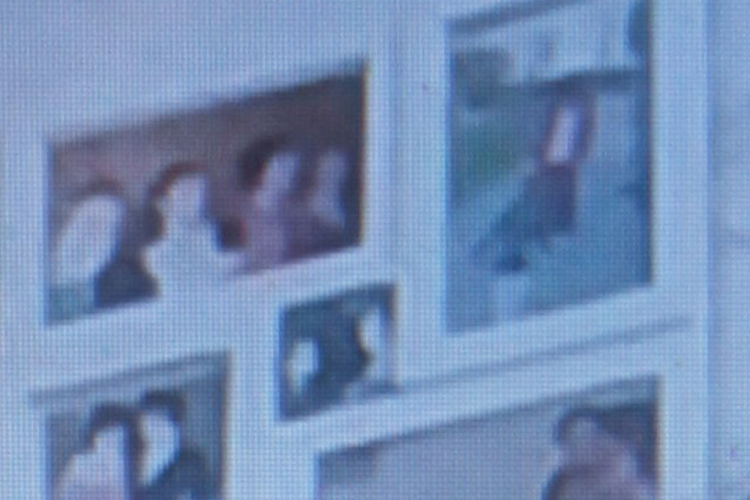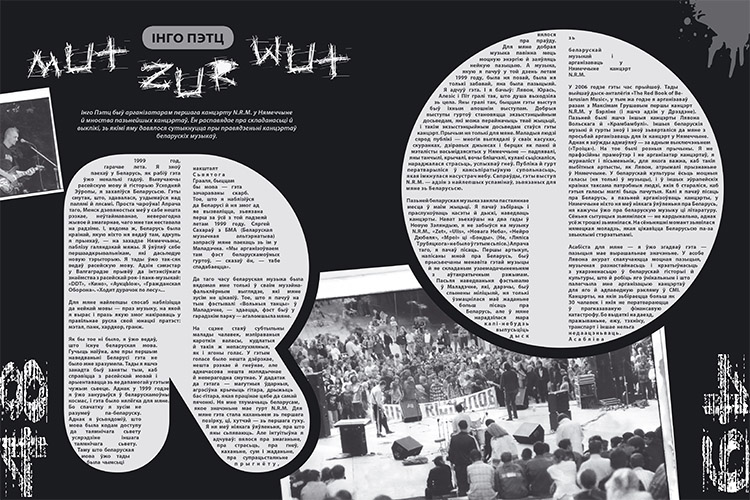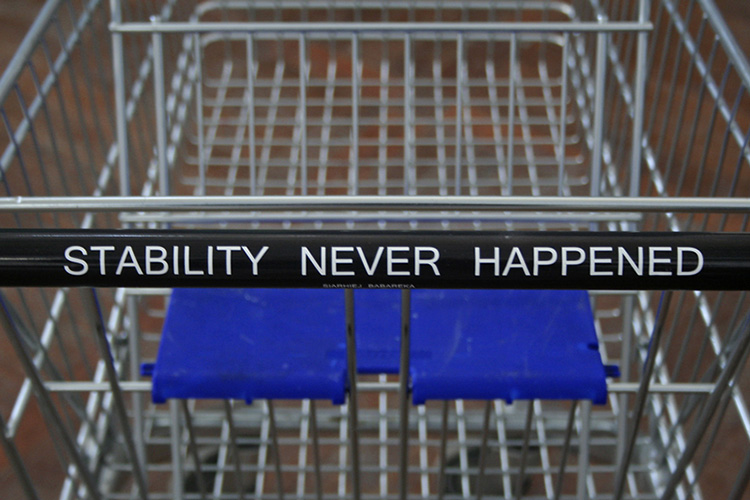
Аўтар: Tania Arcimović, 28/06/2014 | ART Cult Aktivist project
REPLIKA: BELARUSSIAN ART-GENERATION Z
While the narrative of the contemporary Belarusian art of the 1990s and the 2000s is only recently being written (names are regained, facts and phenomena recalled, a struggle with state institutions against the monopolization of history and the spheres of influence is pursued), a number of exhibition-events have been held in Minsk. In this text we will focus on the projects presented at the Gallery of Contemporary Art «Ў» and their analysis enables us to talk about the emergence of a new generation of artists.
What are they like? What distinguishes them from one another and from their predecessors? What makes us think that the partisan era of the 1990s and the times of «total zero» represented by such iconic projects as Ihar Cišyn’s «Light Partisan Movement» and Alaksiej Łunioŭ’s «None» are really over?
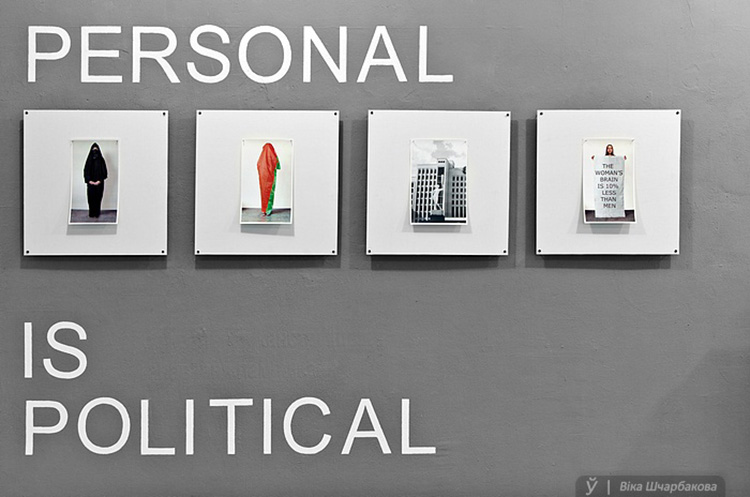
Alesia Žytkievič / BECOMING AN ARTIST. Formation in Four Stories / Gallery Ў 2013
In 2011 the Gallery of Contemporary Art «Ў» worked out a project «Smart Art», the result of which was the presentation of six concepts of young authors — actually, their artistic debut. Raman Aksionaŭ’s project «Immediate» became the winner and thus was fully implemented. Thereafter, the program «Start», later another program «Replika» were launched with the Gallery’s support, aiming at discovering and promoting young artists. A number of exhibitions were held in the Gallery’s small hall and in the bar making the public acquainted with authors previously unknown by a wider art circles. Most often, once having declared their names, they disappeared from art horizons. But over the last two years on the posters one could see more and more familiar names, united not only by the participation in common projects.
They are also characterized by a certain style, the way of dealing with the context, the form of self-perception and the understanding of their place in the contemporaneity. It is these (relatively) common features that allow us to see them in such a «monolith», or as the Belarusian art-generation Z [1].
First of all we mean such collective projects as STRUCTURIZATION (May 2013), BECOMING AN ARTIST. Formation in Four Stories (September, 2013) and a series of solo exhibitions: Self-control by Alaksiej Tałstoŭ (October-November, 2013), In Dazzling White Corridors by Jaŭhien Šadko (February -March 2013) and Angulum Lingo by Alena Haiduk (March 2014). Another exhibition opened at the Gallery within the program «Replika» at the beginning of June. It united four independent artistic statements by Alesia Žytkievič, Alina Šviadkova, Nastassia Hančarova and Uładzimir Hramovič. This example, in my opinion, reinforces the idea that the narrative of the contemporary Belarussian art continues its development making use of the basis of that very period of the 1990s and the 2000s. By the way, the name «Replika» itself, consciously or not, already implied the idea of continuity.
And while the Belarusian humanitarians only make attempts to describe the epoch of the turn of the centuries, these efforts — in the form of various projects (for example, «Belarusian Avant-garde of the 1980s — 1990s», «Zero Radius. Art Anthology of the 00s» or a large-scale exhibition of Siarhiej Kiruščanka «Metabolism of pictorial space»), debates and articles — were enough for young creators to perceive this «oral» history, to feel a part of it and consciously continue their predecessors’ project.
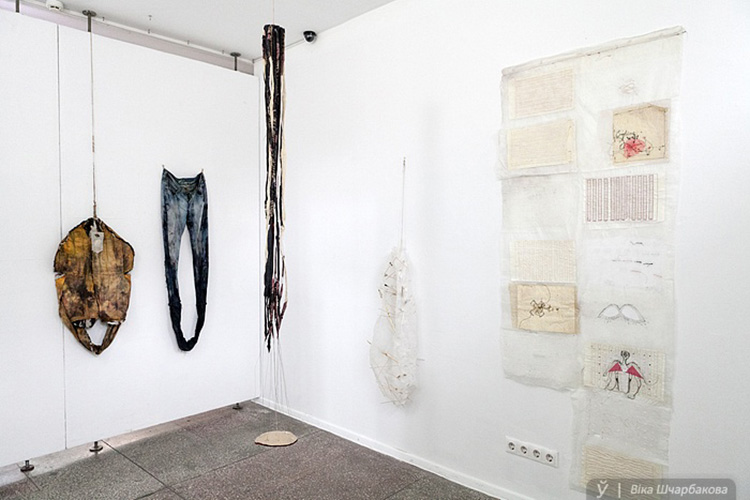
An Installation by Nastassia Hančarova / «Replika» 2014
«ORAL» HISTORY
Comparing the period of the 00s with the previous decade, which is informally called the period of the internal artistic «guerrilla movement» (for example, two major exhibitions — «New Art of Belarus» / Ujazdowski Castle, Warsaw, 2000 and «Open the Door? Belarusian art today» / Contemporary Art Centre, Vilnius, 2010), I came to the conclusion that a paradigm shift in the Belarusian contemporary art clearly occurred. The appeal to the Belarusian «here and now» replaced the «space» escapism. [2] A place has been cleared up for open political statement: politics that started being understood on a wider scale became a conscious field for artistic research. In artistic works the word started functioning in a different way. From abstract elements it turned into concrete actions.
Artists realized their potential in the construction of reality, there have been changes in the understanding of the criteria of their own identity. Namely the Belarusian language viewed only as the territorial borders of Belarus ceased to be the main identification cause. [2]
And there was a return to the global art field: creators began to be openly engaged in the dialogue with the world of contemporary art history, in such a way trying to find and realize their own place (in the context of the country) on the global art map. On the one hand, relationships with the artists of the 1990-2000’s migration wave contributed to this fact with them having been trained and now working in Western countries (especially with Andrej Durejka). On the other hand, a sense of this new global world came alongside with young artists. It became particularly evident in the project «Reliquary XX-XXI (Obituaries XX-XXI)» by Siarhiej Šabochin, whose appearance in the Belarusian art space at the end of the 2000s was really symptomatic and symbolic. Šabochin identifies himself as a representative of «perestroika generation… a hostage of the esthetic rebellion, a supporter of post-Soviet complexes and a new attitude to art». This revolt occurred in criticism and through his appeal to both public institutions (such as the Academy of Art and the Museum of Contemporary Art in his project, «And There Will be Nothing Left»), and independent initiatives (art activism strategy as opposed to «guerrilla» strategy in the project «pARTisan») .
Actually, the work of Siarhiej Šabochin («the artist of the turn of the century»), as well as of such artists of the late 2000s as Michaił Hulin, Antanina Słabodčykava, Žanna Hładko and others summed up the decade becoming, in my opinion, one of the most important impulses for those who followed, although Žanna Hładko might have produced her creative explosion later which nevertheless permits us to refer her growth to the mentioned period.
Z-PARADIGM
While identifying Z-artists, the first thing you notice, and what can really be considered as a tangible result of the work done by independent scholars and critics in recent years, is that unlike, for example, Siarhiej Šabochin who in his creative dialogues addressed the world of such art «icons» as Marcel Duchamp, Marina Abramovic, and others, the Z-authors also consciously include their Belarusian predecessors into this conversation. This occurs both at the level of form and language and in the form of direct quotations. The latter can be traced in Paŭlina Vituščanka’s video «A Young Artist’s Morning Gymnastics» from the project «OffSide» where apart from quoting widely known artists she refers to the statements made by the Belarusians Valancina Kisialova and Alaksiej Łunioŭ.
It is this fact which gives the prerequisites for us to conclude about the existence of the Belarusian contemporary art continuity (and hence the narrative), which, of course, could have been identified there even earlier. It is enough for us to compare the Bismarck’s painting «Four Dumpsters» (1989) and Andrej Durejka’s collage «Academy of Arts» (1997) or Aleś Puškin’s frescoes from the Bobr church and the Maryna Napruškina’s project «Office of Counter-propaganda». But unlike their predecessors, young creators, to my mind, make such references consciously, feeling and asserting themselves as part of the existing history of the Belarusian contemporary art.

Bismarck «Four Dumpsters» (1989) / Andrej Durejka «Academy of Arts» (1997)
This trend is visible in the projects of Alesia Žytkievič, Alina Šviadkova, Nastassia Hančarova, Uładzimir Hramovič and, in my opinion, they make this show symptomatic for the analysis of the contemporary art processes.
For example, in Alesia Žytkievič’s works even earlier you might have noticed the «replicas» of Šabochin’s creativity visible in laconic statements of almost sterile cleanliness and provocative short slogans (eg «personal is political»). And the plate with an inscription «asexual Belarus» in the project «Beyond the Principle of Pleasure» presented in the program «Replika» directly refers to Šabochin’s plate «Consumer» in the project «We are Stern Consumers of Cultural Revolutions». As it was mentioned above, such references, in my opinion, are consciously made. The existence of the predecessors becomes that sort of pivot which allows young artists to find themselves in the contemporary art process in the situation of the prolonged absence of fully-functioning education in the field of contemporary art in Belarus and the lack of opportunities to travel abroad.

Siarhiej Šabochin «Consumer» (2012) / Alesia Žytkievič, from the project «Beyond the Principle of Pleasure» (2014)
Another «replica» is Uładzimir Hramovič’s project entitled «Home Palace». It combines a series of graphics with installation. Multiplied images of puzzles shaped like prefab houses form an anonymous flat body of the modern Belarusian city opposed to the gigantic building of governmental palaces: their shapes on both the sides frame the central composition. In this regard, we may recall Alaksiej Łunioŭ’s project «Multiply» which makes use of the replicated image of a rabbit. Another example is Alaksandr Kamaroŭ’s work «Palace of the Republic» which consists of the images of the corresponding palace presented in various forms. In Hramovič’s project two images of the presidential palace and «palaces» for citizens form a dialogue and thus — a new statement, which seems topical due to the current wave of public interest and the discussion of what is happening with urban space.

Alaksiej Luniou «Multiply» 2014 / Uładzimir Hramovič «Home Palace» 2014
Alina Šviadkova’s works «44 Branches» and «Vacuum» as well as Nastassia Hančarova’s installation «Subtract, Multiply» refer to the newly born classics of the Belarusian contemporary art, namely the installations of Volha Sazykina and Vasil Vasiljeŭ. Perhaps, this impression is created due to the natural materials use, but apart from this the same intimate silence is formed, almost cosmic nomas, as in the works of their predecessors. But this refers only to those means that are used in the formation of their statements. First, it can hardly be called a «rollback» (say, we saw it in the 1990s or 2000s), as in the use of familiar tools that have already become a part of the alphabet of the Belarusian contemporary art we can discern a completely fresh outlook and the vision of contemporaneity. This is especially confirmed by the authors’ accompanying texts. Secondly, a certain nerve (not provocation) can be felt in these «quiet» works, as well as confidence particularly characteristic for the generation Z.
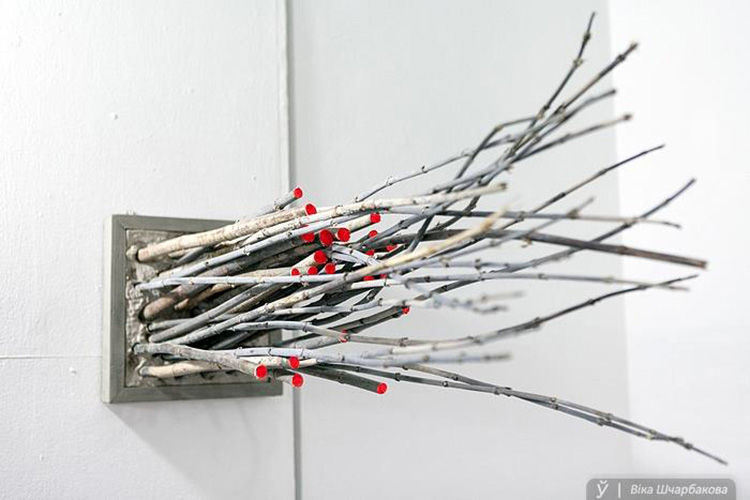
Alina Šviadkova «44 Branches» / «Replika» 2014
In this regard we can recall Alena Hajduk’s project «Angulum Lingo» where the archetypal images of moss and swamp created by the artist in the context of women’s introspection due to its straightness suddenly fall into a bold and even provocative semantic dimension. It is through this delicate balance between the taboo topic (it is almost not verbalized directly) and accurate associations a strong effect is created. Young authors’ accompanying texts present in almost every project are also worth mentioning.
The absence of fear of the word, that is the ability to call a spade a spade, the ability to clearly explain their statements, to be absolutely explicit, as well as rational in the approach to creativity and self-perception as a labor force come to be other characteristic features of theirs.
By the way, in the context of Western European art we can more often see the word «worker» standing next to the word «artist».
There is one more important feature of Z-artists that can be noticed alongside with this conscious existence of oneself within time and space, in my view. I mean the address to the global issues that become topics for their «research» — this term is increasingly used instead of the word «work of art»). Alaksiej Tałstoŭ’s personal project «Self-control» can be mentioned as an illustrative example with globality coming to fore. In «Self-control» the artist presented a series of images iconic for the global media space: Gaddafi, D. Howe, Tibetan monks and others. Interestingly, one of the most frequent questions addressed to the artist was: «And where is Belarus?» At the same time the author himself defined his project as «Belarusian» with contextuality being manifested at another level — it is the apparent lack of Belarus which makes it the main theme. The elements of the global world can be seen in Alesia Žytkievič’s works, too. Dealing with the theme of gender and body, she uses the image of a woman wearing a veil, which is easily perceived and interpreted by us.
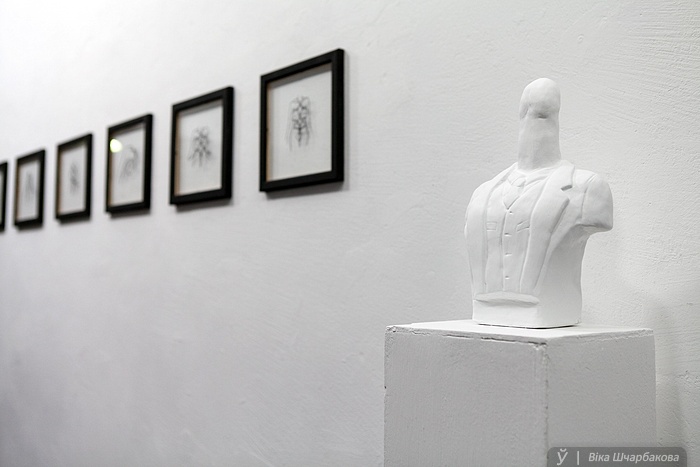
Alesia Žytkievič, from the project «Beyond the Principle of Pleasure» / «Replika» 2014
All these facts confirm the continuation of the processes associated with the search for national identity, which is already manifested differently in the Z-generation: the criteria seem not to be changed or missing. Conversely, if we talk about the Belarusian language, we should note that many young artists do make up their minds to use it. But the boundaries are blurred, or rather, an understanding of these boundaries. The world seems endless, accessible and open. Belonging to a particular territory is important in terms of «where I come from», but it is not the main criterion for self-identification.
«Self» is someone or something more than a representative of a particular local culture, which, of course, is necessary: I feel it and I belong to it. But this is not my goal, because it already exists within me.
Thus, in my opinion, the efforts that independent art space in Belarus has been investing in order to conquer its place in history in the course of the latest decades were not in vain. «Oral» history continues to be written alongside with the one produced by state institutions. Sometimes there is a gap between these stories — it is enough to compare, for example, the exhibition «By 35» produced by the group of young artists of the Belarusian Union of Artists with the «Replika» program. Sometimes they meet within the same space (eg at the exhibition about Kastus Kalinowski’s Uprising). We will see later what happens next.
Tania Arcimovič. Translated by Volha Bubič
[1] Z Generation (Global Generation): з 2000 — … see more
[2] Arcimovič Т. From Isolation to Publicity? / Zero Radius. Art-ontology of the 00s. Minsk, 2013
Opinions of authors do not always reflect the views of pARTisan. If you note any errors, please contact us right away.



